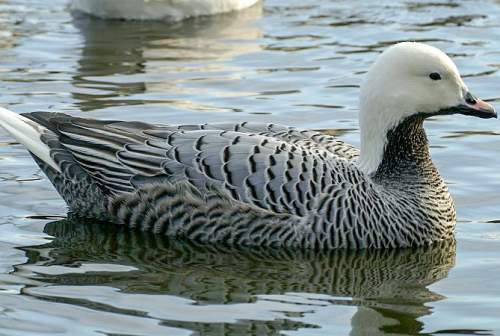Oct 16, 2018
Bird World ›
Ovenbird images ›
Emperor goose - Anser canagicus
The emperor goose is distributed in westmost North America and Far East Russia. This goose species spend its entire life in Arctic and subarctic regions. This goose is monotypic species.
Appearance, physical description and identification
The emperor goose (Anser canagicus) is a large goose, measuring 65 to 90 cm in length and weighing 2000 to 3100 grams. The wingspan is 120 cm. The male is slightly larger.The emperor goose has gray body with fine black and white barring. The head, nape and hinderneck are white. Iron-rich coastal waters may stain the head orange. The throat is dark gray and the tail is white.
The bill is relatively short. The upper beak is grayish at the two ends and pinkish in the middle. The lower beak is bluish gray. The irises are blackish. The legs and feet are bright orange. The call is a loud "quak.. quaak.. quaaak.. quaaak" sound.
 |
| 1.Bird World - Emperor goose - Anser canagicus Image by Ken Billington/http://focusingonwildlife.com/ |
 |
| 2.Bird World - Emperor goose - Anser canagicus Image by Tony Hisgett |
 |
| 3.Bird World - Emperor goose - Anser canagicus Image by Ken Billington/http://focusingonwildlife.com/ |
Origin, geographical range and distribution
The emperor goose is distributed in far west USA, far east Russia and along ice-free coasts around Bering Sea. Vagrant populations have been observed in Canada and Japan.The Important Bird and Biodiversity Areas (IBA) of this species in Russia are, Vankarem lowlands, Meinypylginski and Kapylgyn lakes, Mechigmenskiy Gulf, Lower Anadyr lowlands and Commander Islands.
Some of the IBA of this goose species in USA are, Kuskokwim River Delta, Wide Bay, Kuluk Bay, Seal Islands, Ivanof Bay, Port Heiden, Goodnews Bay, Egegik Bay, Nushagak Bay, Chiniak Bay, Nanvak Bay, Chignik Bay and Kvichak Bay.
Ecosystem and habitat
The emperor goose species does not normally occur in forest. It normally occur in altitudes between 0 to 100 meters.The natural ecosystems and habitats of these species include tundra grasslands, Arctic tundra, coastal lagoons, coastal lakes, intertidal shoreline, tidepools, estuaries and large freshwater lakes.
Diet and feeding behavior
The diet of the emperor goose species consists mainly of plant matter. Grass, leaves of sedges, algae and seaweed are their primary food. These species occasionally take invertebrates.Reproduction and breeding habits
The breeding season of this species is from May to July in most of its breeding range. The nesting sites are located in coastal tundra. The nest is a hollow scrape on the ground and the clutch contains 3 to 6 dirty white eggs.Migration and movement patterns
The emperor goose species is fully migratory. The breeding populations occur in far northeast Russia and extreme west Alaska (USA).These species winter along ice-free coasts around Bering Sea, Aleutian Islands, Canada and the Alaska Peninsula.
Emperor goose - Quick Facts
- Scientific name: Anser canagicus
- Species author: (Sevastianov, 1802)
- Synonyms/Protonym: Anas canagicus Sewastianoff, 1802
- Family: Anatidae › Anseriformes › Aves › Chordata › Animalia
- , Vernacular names: English: Emperor goose, Chinese: 帝雁, French: Oie empereur, German: Kaisergans, Spanish: Ánsar emperador, Russian: Белошей, Japanese: ミカドガン
- Other names: Beach goose, Emperor Goose, Painted goose
- Distribution: USA, Russia
- Diet and feeding habits: seeds, weeds, grass, invertebrates
- IUCN status listing: Near Threatened (NT)
Conservation and survival
The global population size of the emperor goose (Anser canagicus) is estimated to number more than 85,000 individual birds (U.S. Fish & Wildlife Service 2001). The overall population trend of the species is considered to be decreasing.In most of its range, this species is reported to be rare to uncommon. The generation length is 8.9 years. Its distribution size is about 775,000 sq.km.
Habitat alteration, hunting for food, climate change, severe weather, human disturbance and trapping of adults and juveniles for pet-trade are the main threats that are endangering the survival of this goose species.
IUCN and CITES status
The emperor goose (Anser canagicus) is approaching the thresholds for being Vulnerable, under the range size criterion, under the population trend criterion and under the population size criterion.The IUCN (International Union for Conservation of Nature) has categorized and evaluated the goose species and has listed it as "Near Threatened".
The CITES (Convention on International Trade in Endangered Species of Wild Fauna and Flora) status is ‘Not Evaluated’ for the emperor goose (Anser canagicus).
1.Image source: https://commons.wikimedia.org/wiki/File:Emperor_Goose_(Chen_canagica)_(3).JPG (cropped)
Author: Ken Billington/http://focusingonwildlife.com/ | License: CC BY-SA 3.0 as on 10/16/18
2.Image source: https://www.flickr.com/photos/hisgett/5370597811/ (cropped)
Author: Tony Hisgett | License: CC BY 2.0 as on 10/16/18
3.Image source: https://commons.wikimedia.org/ (cropped)
Author: Ken Billington/http://focusingonwildlife.com/ | License: CC BY-SA 3.0 as on 10/16/18
Detailed description and information on distribution, habitat, behavior, feeding and breeding habits, migration and conservation status of beautiful birds with their images.
Recently updated and current topic in Bird World: Emperor goose - Anser canagicus
